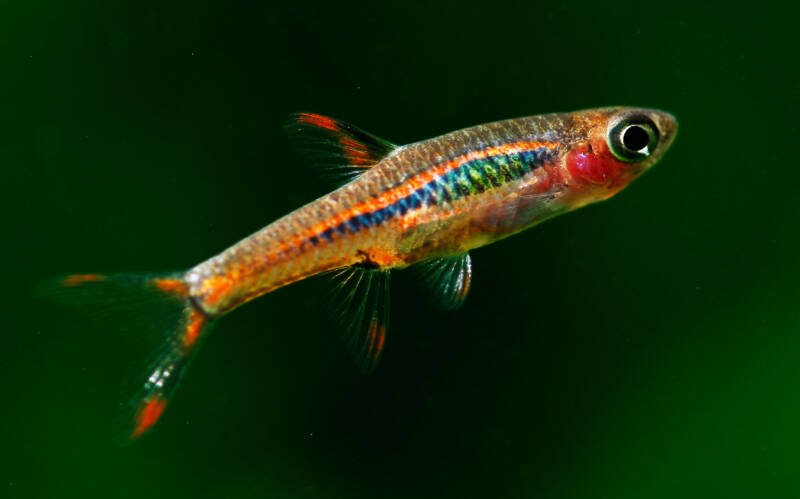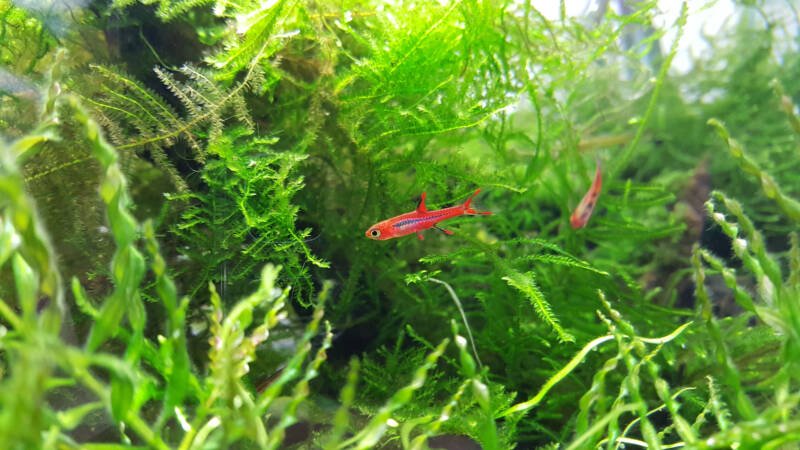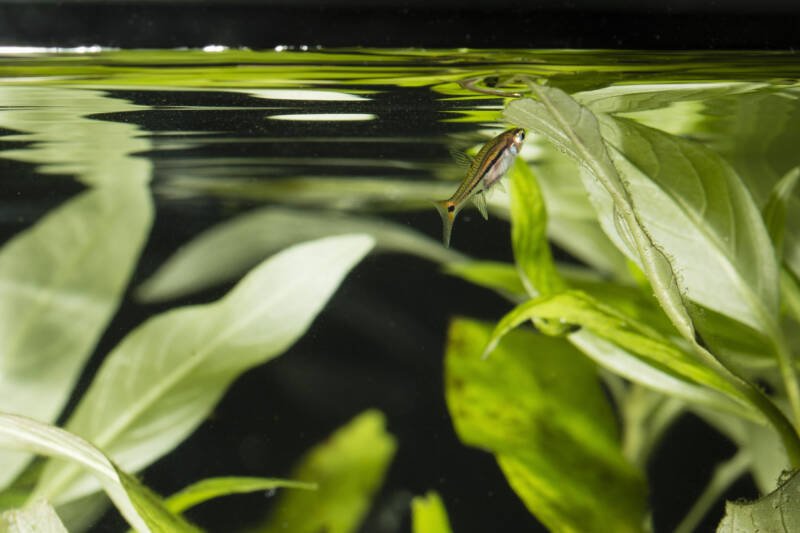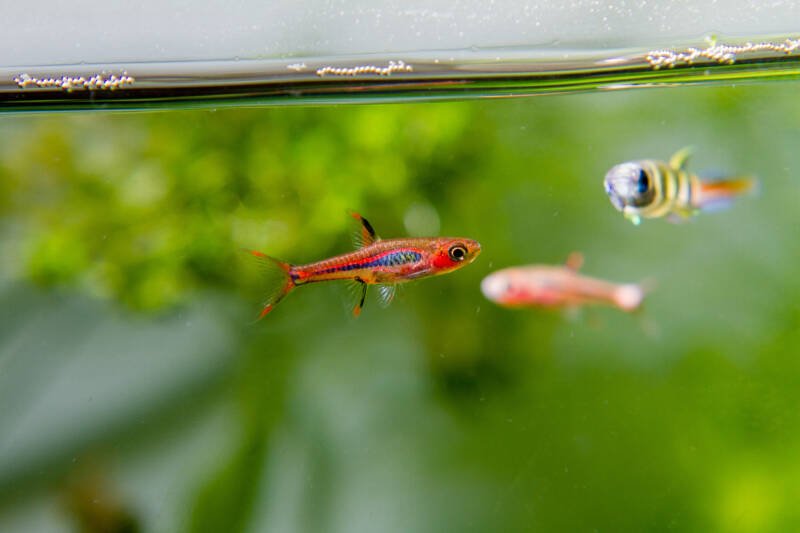The chili rasbora is a tiny, brightly colored freshwater fish that is a favorite for keepers of both nano tanks and larger community tanks.

This wonderfully peaceful fish, also known as the mosquito rasbora, loves to school with others of its kind, creating a lovely ripple of color in the middle to upper levels of your tank.
This is one hardy fish. It is not particularly susceptible to any unique diseases and has a fairly long lifespan.
However, some of the fish’s unique care requirements may be a slight challenge for a novice.
The chili rasbora has some intolerance to shifting water temperatures and specific needs regarding the tank’s water conditions.
To ensure a long and healthy life for your new chili rasbora, take the time to learn about its care and upkeep of the tank.
Armed with this knowledge, you will be ready to embark on the adventure of caring for and even breeding this excellent addition to your home aquarium.
At a Glance
| Minimum tank size: | 5 gal (19 l) |
| Group Size: | Six or more |
| Water temperature: | 68-82°F, ideal 74; 20-28°C, ideal 23 |
| pH: | 4.0 to 7.0, ideal 5.0 |
| Hardness: | 3 to 12 dKH |
| Lifespan: | Four to eight years |
| Breeding: | Egg scatterer |
| Adult size: | 0.8 inches (2 cm) |
| Usual Place in the Tank: | Middle to upper levels |
In this article
Natural Habitat
The chili rasbora (Boraras brigittae) hails from southwestern Borneo. This tiny fish lives in quiet waters, heavily infused with peat and thus with very low acidity.
The bottoms of these streams and standing water are littered with decaying plant material and feature numerous roots and aquatic plants for hiding spaces.
Light reaching the water is filtered through overhanging branches.
Appearance

It is easy to see the appeal of the chili rasbora as an aquarium fish.
They are beautifully colored; their red bodies are accented with a horizontal dark stripe down the side. Above the dark stripe is another vibrant stripe of red.
Their delicate fins are mostly transparent, with a touch of black at the base.
In addition, male chili rasboras tend to be more brightly colored and feature splashes of red on their dorsal, anal, and tail fins.
Females can be slightly bigger in length and girth, with less vibrant colors.

Size
These are tiny fish. Growing to an average length of only 0.8 inches (2 cm), this species is classified as a “nano fish.”
Lifespan
With proper care, you can expect to have your chili rasbora’s beautiful colors gracing your tank for a good amount of time.
These fish can live anywhere between four to eight years. Keep up the water and tank conditions to ensure your fish has a long life.
Behavior
If you are looking for a gentle tempered fish, this is the one! Chili rasboras are peaceful, schooling fish.
They spend most of their time swimming together through the middle to upper parts of the tank.
They will occasionally explore the bottom hiding spots and grassy areas if you have these in your tank.
How many per gallon?
Because these fish are a bit shy, it is best to keep them in a group to encourage their natural schooling behavior.
We recommend a group of at least six. These fish are often sold online in groups ranging from three to 24.
A school of up to six fish can be kept in tanks as small as five gallons. Consider a larger tank if you plan to have live plants and/or other species.
As with any fish, more space to swim, and plenty of hiding places make for a happier environment.
Tank setup
Ideally, the chili rasbora does best in a species-only tank; that is, a tank where they are the only occupants.
Because of their small size, this is easy to do without a huge budget. A five-gallon tank will hold a small school of them.
Water Parameters
The biggest challenge with chili rasboras is that they are somewhat sensitive to water conditions.
Their natural habitat has very soft water. Keep the hardness of the water in your tank between 3 and 12 dKH.
The pH value should also be kept low, ideally from about 4.0 to 5.0; however, the fish can survive in water with a higher pH of 6.0 to 7.0.
Start with a blend of distilled water or reverse osmosis water and tap water.
Avoid straight tap water as the minerals and chlorine content typically present are too high for the chili rasbora. Using a water filter does not help as it can add high amounts of sodium to the water.
Add peat moss, peat pellets, alder cones, or Indian almond leaves to adjust the pH and slightly stain the water.
The resulting water, often called blackwater, should be clear yet tinted due to the tannins released from the added plant material.
Test the water for pH and hardness before adding your fish. Continue to monitor the levels using test kits that you can purchase in most stores.
Maintain a water temperature between 68 and 82-degrees Fahrenheit (20 to 28 degrees C), with the ideal being around 74 degrees.
If you are keeping the fish in a nano tank, a heater is a good investment, as the small amount of water can change temperature quickly due to temperature fluctuations in the surrounding air.
Clean the gravel in your tank periodically using a siphon. Change out a portion of the water monthly to prevent the buildup of unwanted ammonia and nitrite.
Decorations
Start with a fine, dark-colored substrate.

Add live aquatic plants and floating plants to provide the hiding places and plant cover typically found in their natural habitat.

Try Java moss or Java fern or Anubias nana. These plants do well with low light and will help oxygenate the tank.

Live plants also promote habitats for smaller organisms, such as worms, on which the chili rasboras can snack.
Set up areas where there is thicker plant cover as well as open water areas for swimming.
Equipment
Proper filtration and lighting are also important for the chili rasbora.
Because this species is used to gentle waters in its natural habitat, the flow of whichever filter you install should be set as low as possible.
Break up the water flow with plants or other decorations and clean the filter every few weeks.
In keeping with the desire to recreate the natural habitat, plan on low lighting.
The planted areas and floating plants, if you have included them, will help diffuse the lighting and create a more comfortable environment for your chili rasboras.
Consider an LED aquarium light that allows for some dimming and avoid leaving the tank in direct sunlight for long periods.
A timer on the light can help ensure an 8 to 12-hour cycle.
Tank Mates

As mentioned before, the best tank setup for chili rasboras is as a species-only tank. These shy and peaceful fish love schooling with other mosquitoes.

They will get along fine in community tanks, provided they are kept with other small and peaceful fish.
Any larger fish and you risk having your mosquito rasboras end up as food!
Consider the following tank mates for your chili rasboras:
- Celestial pearl danios
- Chocolate gouramis
- Cory catfish
- Dwarf shrimp (RCS, bamboo, ghost, or Amano shrimp)
- Dwarf rasboras
- Otocinclus
- Neon tetras
- Sparkling gouramis.
Avoid the following:
- Any large or aggressive fish would consider the chili rasbora a snack.
Food and Diet
As you might expect, this tiny species requires small-sized food sources. In the wild, they eat all types of microscopic foods, such as plankton and worms.
For your aquarium, you would do well to feed your chili rasboras a varied diet, including micropellets, baby brine shrimp, and small worms.
The fish will also love tubifex, chopped bloodworms, and Daphnia. You can use commercial flake food if you grind it finely.
Breeding
Chili rasboras are continuous spawners, meaning that there will be numerous opportunities to breed them.
When ready to breed, the males can develop brighter coloration, and females may appear more rounded with eggs.
Set Up a Breeding Tank
Because chili rasboras can eat the newly-born fry, it is best to set up a separate breeding tank. A heavily-planted tank bottom will better conceal and protect the eggs.
The males can display territorial behavior as they attempt to attract the attention of the females.
Once mating is complete, the female will scatter the eggs along the bottom of the tank.
When she is done, remove the parents from the breeding tank so that they do not eat the eggs or newly-hatched fry.
Caring for the Fry
Once the fry hatch, usually within a few days, they will feed off their egg sac for the first 24 hours.
After that, feed them infusoria for about 10 days or so. Then, they will have grown large enough to eat microworms.
Keep them in the breeding tank until they have grown large enough to be introduced to the community tank.
Hardiness
Again, the biggest issue with the hardiness of chili rasboras is overcome by maintaining good water conditions.
Other than that, they are not particularly susceptible to any unique diseases. The typical things to look for are those that impact any freshwater aquarium fish: parasite and fungal infections.
The one issue you are most likely to encounter is ich. This parasitic infection presents as white, itchy spots on your fish’s body. It is very contagious, so treat it as soon as you notice it.
Many times, this infection can be avoided if the tank conditions are kept up.
Stressed fish are more susceptible to disease. If your fish does contract ich, separate them and treat them with medication.
Frequently Asked Questions
1. Are chili rasboras hardy?
Yes! Chili rasboras are very hardy fish and are not prone to any unique diseases.
They are, however, impacted by water conditions in the tank.
To ensure a long life for your fish, monitor your tank’s temperature, pH, and hardness levels, and ensure they are within healthy parameters for your fish.
2. How big do chili rasboras get?
This tiny fish does not grow more than 1 inch or 2.5 cm and is considered “nano fish” in the aquarium trade.
3. Do chili rasboras need a heater?
A heater is recommended for any tank containing chili rasboras.
This species is sensitive to water temperature fluctuations, and the volume of water in smaller tanks can change quickly depending on the room’s temperature.
4. How long do chili rasboras live?
Chili rasboras have a decent lifespan of four to eight years.
To help ensure a long life for your fish, take care of them with a well-balanced diet, steady water and tank conditions, and an interesting tank environment.
5. Will chili rasboras eat baby shrimp?
Happily, chili rasboras are friendly toward dwarf shrimp. You can feel safe pairing your rasboras with many freshwater shrimp species, including cherry, wood, ghost, or Amano shrimp.
Chili rasboras won’t bother baby shrimplets and let them alone.
Final Recommendations
The chili rasbora is a beautiful schooling fish that makes a delightful addition and splash of color to either a nano tank or a community home aquarium.
These peaceful fish will tolerate several similarly sized and tempered species, making for a fun mix.
The biggest challenge in keeping chili rasboras lies in maintaining water and tank conditions.
As such, some experience in aquarium keeping may be beneficial to someone planning on adding this species to their tank.
Plan on monitoring the temperature and composition of the water, as well as regular tank cleaning, to ensure your chili rasboras thrive.
You can keep as few as two chili rasboras, but they do prefer to be in groups. We recommend a group of at least six. These fish are often sold online in groups ranging from three to 24.
In addition to your fish, plan on purchasing water testing kits to monitor water conditions, a heater to maintain the temperature, and some plants to provide cover.
What is your experience with keeping Chili rasboras?
What foods do your fish prefer?
What are your favorite live plants to add to your aquarium?